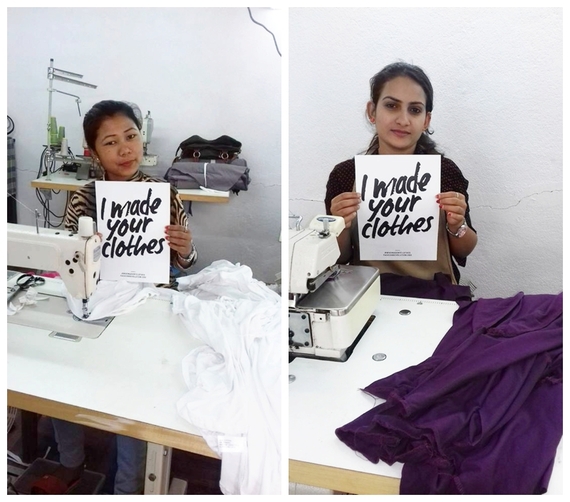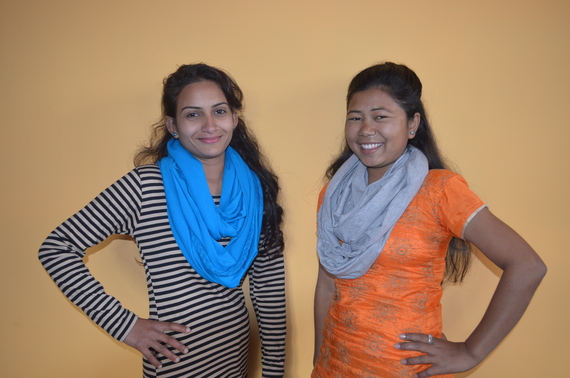I thought I would never forget it.
April 24th, 2013.
An 8-story garment factory collapsed in Bangladesh.
It was all over the news for days.
Although garment factory workers had noticed the cracks in the walls the day prior and had taken their concerns to the building owners, they were ordered to come back to work the following day, despite the bank and shops on the 1st floor being shut down.
During the morning rush hour, the whole building collapsed.
More than 1,000 people died. More than 2,500 were hurt.
Absolutely horrific.
Over the last three years, I have heard story after story of unfair treatment in the fashion industry.
Safety compromised. Buildings collapsing. Wages so low that parents go without food so their children can have morsels to eat. Lives threatened. Bodies beaten. Children working in sweatshops.
And let's have a heart to heart, friend.
I know that you know this is happening too.
It's no secret that unfair treatment is behind the majority of the garments hanging in our closet.
It's the world's worst kept secret that carries with it close to zero guilt.
Let that sink in.
Because let's be honest.
For the love of a gorgeously-printed Kimono, we will choose to sacrifice someone's safety and dignity to wear our new find with great pride.
What's worse?
Almost every time we compliment someone these days on a pair of shoes or a new dress they're wearing, what follows is usually something like:
"Thanks so much! Old Navy -- only $12!"
We wear a good deal like a badge of honor while someone on the other side of the world is slaving away for pennies in hopes that their children can have food for the week.
So there I sat after the news coverage of the Rana Plaza collapse had faded -- contemplating my life choices a few weeks later.
And I realized that if I was honest with myself, I didn't give a big enough sh*t to change my spending habits.
And I felt like the rest of the first world was right there with me.
Sometimes when we examine our hearts, it's not pretty, is it?
I wanted to force myself to care, but I wasn't sure of a way forward.
So, as one does when they are wildly misdirected, I decided to move forward with the world's worst strategy ever. I decided that I would only spend $75 on clothes for a year.
I wanted to force myself to minimize the negative impact I would have.
So you might be wondering -- what did I buy with the $75?
Well, for starters, my girlfriends convinced me to buy a $25 black leather cut off skirt at a 'Vintage Store' (it was more like a yard sale with a roof) in Baltimore over the summer.
I couldn't breath in the skirt and had no idea where I would wear such a travesty of a garment, although I will say that it did prove to be quite the good fashion statement for a Mean Girl's skit at my bff's bachelorette party.
BUT I AM STILL MAD AT ALL OF YOU GIRLS.
The remaining $50 I spent on the clearance rack at Target on neon reversible skirts and a few senseless tops when all I really walked in to get was a bottle of shampoo.
Do you see why this strategy was such a flop?
The struggle was real.
In early 2014, I started hearing about companies that were making clothes ethically, some even showing the faces and stories of the people that were making their garments.
Enter Elegantees.
I stumbled across their website and fell in love with their mission to employ survivors of sex trafficking to make their beautiful garments.
Katie, the founder, studied fashion in NYC, worked in the industry, and the topic of human trafficking became a burden on her.
Around three years ago, she met people from The Nepali Rescue Project, and they shared their vision of wanting to take 500 girls that had been rescued from trafficking and unspeakable, unimaginable things -- and help them recover and give them an employment opportunity.
Katie knew that she didn't want to use normal factories for the women's fashion line she had launched. She wanted her pieces to be made by survivors and their stories to come alive through the garments.

Photo courtesy of The Flourish Market.
Today, nine women make the gorgeous pieces designed by Elegantees, and each piece truly encapsulates their tagline 'sewn to restore.'
Meet Gita and Binita.
Photo courtesy of The Flourish Market.
They were both victims of sex trafficking until they were rescued at the Nepali-India border where their traffickers had them in route to the Middle East. Once they were rescued, they received counseling and healing from The Nepali Rescue Project, and during that process they learned how to sew.
Today, they love to sew Elegantees for a living and are finding more joy in life.
They are forever overcomers.
The last year has not been easy for Nepal. Almost one year ago, a devastating earthquake hit the country, claiming 8,000 lives and injuring more than 17,000. The country all but shut down, and it became extremely difficult for survivors to move forward, both emotionally and logistically.
The large fabric order for the season that was in transit to the sewing workshop was lost, and everyone was scared in the months following the earthquake, for their safety and for their jobs.
Then this past September, a fuel strike was imposed on Nepal by India, blocking their border for deliveries of fuel, medical supplies, and essentials needed to live.
Through all of this, Elegantees has linked arms with the women at the sewing center to persevere.
Although the sewing workshop has a generator for times when the government needs to cut power, finding fuel to run it had been nearly impossible for months.
Always solution-oriented, and with a strong will to keep the courageous women behind their garments employed, Katie has worked with Gita, Binita and the team to come up with creative solutions over the last year, and great news -- the border re-opened ealier this month.
So now, here I sit. A few years later. Realizing that I now almost exclusively buy ethically-sourced clothes.
And I wonder...what changed?
It's been people like Katie, Binita, and Gita that have won over that ugly place in my heart. They have taught me to care about the people who make my clothes.

Photo courtesy of The Flourish Market.
While it sadly wasn't convincing enough for me to not want to be a part of the problem, it has been 110 percent compelling to be a part of the solution.
I see the 491 women on that waiting list and I deeply desire for them to be employed.
In the past, I viewed shopping ethically as a burden, but now I view it as an exciting opportunity.
Every purchase we make has the opportunity to lay a strong foundation in the fashion industry that sends a message that we care about the livelihood of those who make our clothes.
Today (and every day!), I invite you into a movement so good. So full of promise. The opportunity to use your purchasing power for good.

